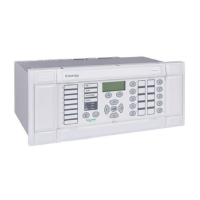Operation P54x/EN OP/La4
MiCOM P543, P544, P545 & P546
(OP) 5-33
OP
Note: Any existing trip decision is not reset under this condition. After the
first cycle following a selection, the phase selector is only permitted to
change to a selection involving additional phases.
On double phase to ground faults, only the appropriate phase-phase elements are enabled.
The indication of the involvement of ground is by operation of a biased neutral current level
detector.
1.10.1 Theory of operation
Selection of the faulted ph
ase(s) is performed by comparing the magnitudes of the three
phase-to-phase superimposed currents. A single phase-to-ground fault produces the same
superimposed current on two of these signals and zero on the third. A phase-to-phase or
double phase-to-ground fault produces one signal which is larger than the other two. A three
phase fault produces three superimposed currents which are the same size. Reference is
made to Figure 17 to show how the change in current can be used to select the faulted
pha
ses for a CN fault.
AB
BC
CA
Change!
Change!
No
Change!
1 Cycle
Comparison
1 Cycle
Comparison
Ground Fault,
Phase C
P1179ENa
P1134ENa
Figure 17 Phase to phase currents showing change for CN fault
A superimposed current is deemed to be large enough to be included in the selection if it is
greater than 80% of the largest superimposed current.
A controlled decay of the superimposed threshold ensures that the phase selector resets
correctly on fault clearance.
Phase selection can only be made when any superimposed current exceeds 4% of nominal
current (In) as a default value.
Under normal power system conditions, the superimposed currents are made by subtracting
the phase-phase current sample taken 96 samples (2 cycles) earlier from the present
sample.
When a fault is detected, resulting in a phase selection being made, the “previous”
memorized sample used in the superimposed current calculation is taken from a re-cycled
buffer of “previous” samples. This ensures that, if the fault develops to include other phases,
the original selection is not lost. The re-cycling of the prefault buffers is continued until the
phase selector resets, either because the fault is cleared or when the 5 cycle period has
expired and no element has operated.

